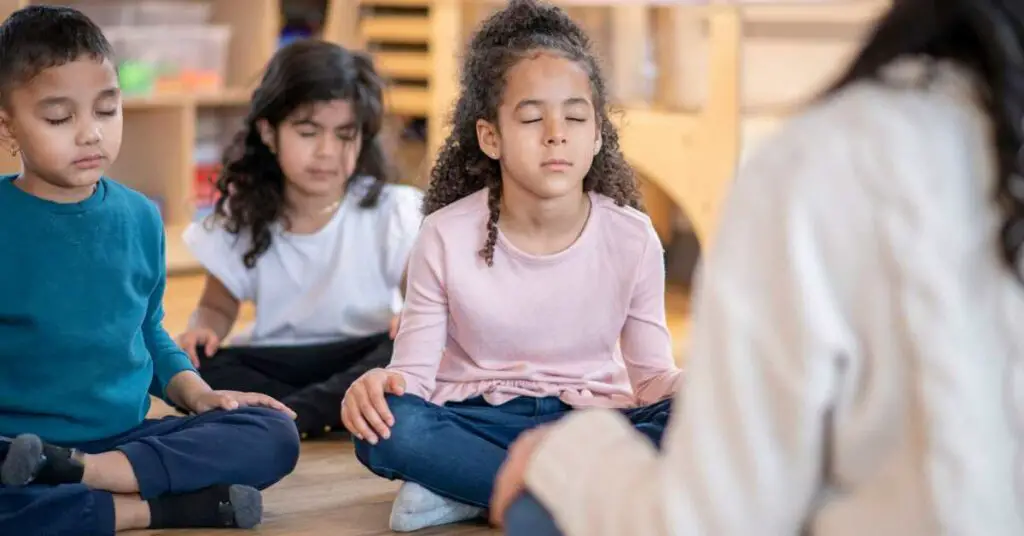Meditation is an ancient practice that has been used for thousands of years to promote physical, mental, and emotional well-being.
In recent years, meditation has become increasingly popular as a tool for managing stress, anxiety, and other mental health issues. While meditation is often thought of as a practice for adults, it can also be beneficial for children of all ages.
The benefits of meditation for children are numerous. Research has shown that meditation can help children develop important life skills, such as focus, attention, and self-awareness. Meditation can also help children regulate their emotions, cope with stress, and improve sleep.
Additionally, meditation has been found to enhance cognitive development and academic performance in children, as well as foster empathy and compassion towards others.
The purpose of this article is to provide an overview of the benefits of meditation for children, as well as practical tips and guidance for parents and caregivers who wish to introduce meditation to their children.
We will discuss the age at which children can begin meditation, different types of meditation suitable for children, and how parents and caregivers can support and encourage their children’s meditation practice.
Whether you are a parent, teacher, or caregiver, this article will provide you with the knowledge and tools you need to help your child reap the benefits of meditation.
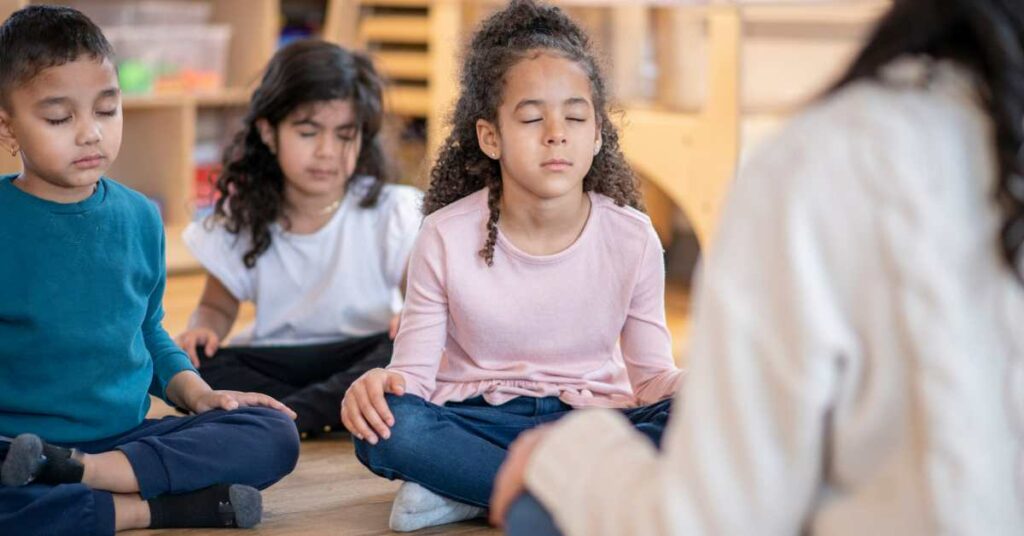
Is it good to teach meditation to children?
Meditation is a valuable tool for promoting well-being and improving mental health, and it can be just as effective for children as it is for adults. There are many reasons why teaching meditation to children can be beneficial:
- Meditation can help children develop important life skills, such as focus, attention, and self-awareness.
These skills can help children become more successful and resilient in school, social situations, and other aspects of life.
- Children are capable of learning and practicing meditation, even at a young age. With guidance and support, children can develop the ability to quiet their minds, focus their attention, and regulate their emotions through meditation.
- The benefits of meditation for children are well-documented. Research has shown that regular meditation practice can improve sleep, reduce anxiety and stress, increase self-esteem, and enhance cognitive development and academic performance.
Overall, there are many reasons to teach meditation to children. By providing children with the tools they need to develop greater focus, attention, and emotional regulation, we can help set them on a path toward greater well-being and success in life.
At which age can children begin meditation?
Meditation is a practice that can benefit people of all ages, including children. However, the question of at what age children can begin practicing meditation is a common one among parents and caregivers.
The answer is that children can start meditating as young as 2 or 3 years old, but the ideal age to start teaching children meditation is around 6 or 7 years old.
It’s important to understand that the ability of children to understand and engage in the practice of meditation is the key factor when considering when to start teaching them.
At around the age of 6 or 7, children’s brains have developed enough to begin understanding basic concepts and instructions related to meditation.
At this age, children can learn how to sit still, focus on their breath, and let go of thoughts and distractions.
That being said, younger children can still benefit from simple forms of meditation that can help them calm their minds and develop mindfulness. Simple techniques like counting breaths or focusing on a particular object can be taught to younger children to help them relax and cope with stress and anxiety.
Ultimately, the decision of when to start teaching children meditation should be based on the child’s individual development and readiness.
Parents and caregivers should be patient and supportive in helping children learn and develop their meditation practice, no matter what age they begin. With time and practice, children can reap the benefits of meditation, including increased focus, reduced stress, and improved emotional regulation.
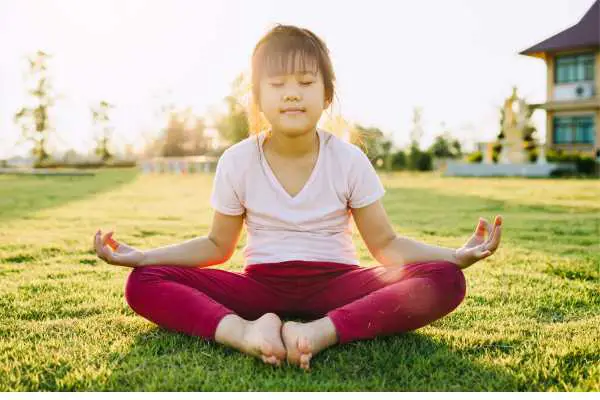
Benefits of child meditation.
Meditation is a practice that has been gaining popularity among adults for its numerous benefits, such as stress reduction, improved mental clarity, and increased focus. But did you know that children can also benefit from practicing meditation?
In fact, teaching children to meditate can help them develop important skills such as self-awareness, emotional regulation, and empathy. In this section, we will explore the benefits of meditation for children and how it can positively impact their lives.
1. Improved focus and concentration
Children who meditate regularly can develop better focus and concentration skills. Meditation involves training the mind to stay focused on one thing, such as the breath or a mantra. This can help children develop the ability to concentrate better, which can be useful for academic and daily life activities.
2. Reduced stress and anxiety
Meditation can help reduce stress and anxiety in children. When children learn to meditate, they also learn how to manage their thoughts and emotions in a healthier way. This can help reduce feelings of stress and anxiety and improve their overall sense of well-being.
3. Increased emotional regulation and self-awareness
Through meditation, children can learn to recognize and regulate their emotions. By observing their thoughts and emotions during meditation, they can learn to better understand themselves and their emotional responses. This can lead to greater emotional intelligence and self-awareness.
4. Improved sleep
Children who meditate regularly may experience improved sleep quality. Meditation can help calm the mind and body, making it easier for children to fall asleep and stay asleep.
5. Increased empathy and compassion
Meditation can help children develop greater empathy and compassion towards others. By cultivating a sense of mindfulness and connection to the world around them, children can learn to be more compassionate and understanding of others.
6. Enhanced overall well-being
Regular meditation practice can contribute to a child’s overall sense of well-being. By promoting positive emotions and reducing stress and anxiety, meditation can help children feel happier, more peaceful, and more fulfilled.
How long should children practice meditation each day?
When it comes to how long children should practice meditation each day, consistency is more important than duration. Even a few minutes of daily practice can be beneficial for young children.
As they get older, they can gradually increase the duration of their meditation sessions.
The exact duration of the meditation session will depend on the child’s age, ability to focus, and personal preferences. Younger children may have a shorter attention span, so it may be best to start with shorter meditation sessions and gradually increase the time as they become more comfortable with the practice.
It’s important to keep in mind that meditation should not feel like a chore for children. Encouraging them to meditate for too long or too frequently can actually have the opposite effect and make them feel resentful towards the practice.
Instead, it’s better to encourage consistent daily practice, even if it’s only for a few minutes at a time. As children get older, they can gradually increase the duration of their sessions as they develop more comfort and proficiency in the practice.

Practical tips for teaching meditation to children
Teaching meditation to children can be a rewarding experience for both the child and the adult. Here are some practical tips for making the experience fun and engaging:
- Make it fun and engaging through playful activities and games: Children have a short attention span, so it’s important to make meditation enjoyable for them.
Engage them in playful activities and games that involve mindful breathing, visualization, and movement. You can use props like bubbles, music, and soft toys to keep them engaged.
- Use age-appropriate language and concepts: Use simple and easy-to-understand language when explaining meditation to children.
Use examples that relate to their daily life, such as visualizing a peaceful garden or a happy place. You can also use stories, songs, and poems to introduce meditation concepts.
- Create a peaceful and comfortable environment for meditation practice: Choose a quiet and peaceful place for meditation practice.
Create a comfortable space with soft lighting, cushions, and blankets. You can also use essential oils or incense to create a relaxing atmosphere.
By following these tips, you can make meditation a positive and enjoyable experience for children. Remember to be patient and allow children to explore meditation at their own pace. With practice, children can develop a lifelong habit of mindfulness and inner peace.
Supports children with ADHD or autism spectrum disorders through meditation
Meditation can be a valuable tool in supporting children with attention deficit/hyperactivity disorder (ADHD) or autism spectrum disorders (ASD).
ADHD is a neurodevelopmental disorder characterized by inattention, hyperactivity, and impulsivity, while ASD is a developmental disorder that affects communication, social interaction, and behavior.
Research has shown that meditation can help children with ADHD or ASD learn to focus and manage their symptoms. Mindfulness-based techniques, in particular, have been shown to be effective in helping children with ADHD stay present and engaged.
These techniques involve paying attention to the present moment and being aware of thoughts, feelings, and sensations without judgment.
For children with ASD, meditation techniques that focus on regulating emotions and improving social skills can be beneficial. These techniques can help children learn to recognize and manage their emotions, communicate effectively, and interact with others in a more positive and cooperative manner.
Overall, meditation can be a useful addition to the toolkit for supporting children with ADHD or ASD, providing them with a set of skills to help manage their symptoms and improve their quality of life.
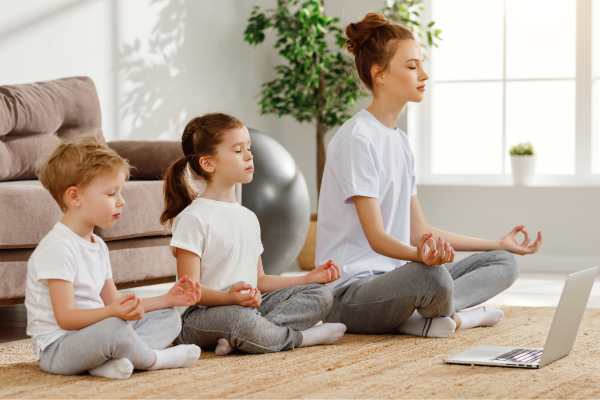
Different types of meditation suitable for children
Meditation offers children a variety of benefits, from reduced stress and anxiety to improved focus and emotional regulation.
Different meditation techniques are suitable for children of different ages and with different needs.
- One popular form of meditation for children is mindfulness meditation, which involves paying attention to the present moment without judgment.
This technique can be particularly helpful for children who struggle with anxiety or hyperactivity.
- Another type of meditation that can be beneficial for children is loving-kindness meditation. This practice involves cultivating feelings of love, kindness, and compassion towards oneself and others.
Children who practice loving-kindness meditation may become more empathetic and compassionate towards others, as well as learn to be more self-accepting.
- Body scan meditation is another technique that can be beneficial for children. This practice involves paying attention to physical sensations in the body, which can help children relax and become more aware of their body’s signals.
Body scan meditation can be particularly helpful for children who have trouble falling asleep or who experience physical symptoms of stress or anxiety.
Overall, there are many different types of meditation suitable for children, and parents or teachers can experiment with different techniques to find what works best for each child.
By incorporating meditation into their daily routine, children can develop a valuable tool for managing their emotions and cultivating inner peace.
How parents and caregivers can support and encourage children’s meditation practice
Meditation can be a beneficial practice for children, but it can be challenging for them to establish a regular practice without support and encouragement from parents or caregivers.
Here are some tips on how parents and caregivers can support and encourage children’s meditation practice:
1. Model meditation practice
Children are more likely to adopt a new behavior if they see adults around them doing it regularly.
If parents or caregivers have regular meditation practice, children are more likely to see it as a valuable and normal part of daily life.
2. Encourage children to share their experiences and ask questions
Engage children in conversations about their meditation practice.
Ask them how they feel after meditating, what they noticed during their meditation, or if they have any questions about the practice. This can help children stay engaged and curious about meditation.
3. Praise children for their effort and progress
Praising children for their effort and progress can help build their confidence and motivation to continue practicing.
Acknowledge their commitment to the practice and celebrate small successes along the way.
By supporting and encouraging children’s meditation practice, parents and caregivers can help them establish lifelong habits that can benefit their physical, mental, and emotional well-being.
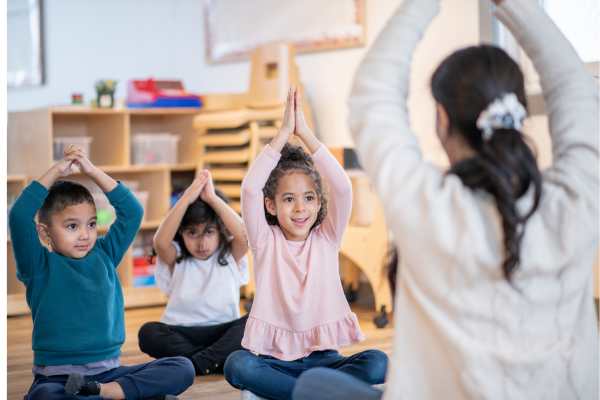
Overcoming common challenges in teaching meditation to Children
Teaching meditation to children can be a rewarding experience, but it can also come with some challenges. Here are some common challenges and tips for overcoming them:
- Children may find it challenging to sit still or focus their minds during meditation practice and may need support and encouragement to persevere.
To make the experience more enjoyable and engaging, consider using guided meditations, incorporating movement or sensory activities, and keeping the sessions short and age-appropriate.
- Parents and caregivers may need to adapt their approach to suit individual children’s needs and preferences.
Some children may respond better to a structured routine, while others may benefit from more flexibility and variety. It’s important to observe and listen to the child’s needs and preferences, and adjust accordingly.
- Consistency and persistence are key to helping children develop a regular meditation practice and reap the benefits over time.
It’s important to establish a regular routine and encourage the child to practice regularly, even if it’s just for a few minutes a day. It’s also helpful to set realistic expectations and celebrate small successes along the way.
By overcoming these common challenges and establishing a consistent and enjoyable meditation practice, children can develop valuable skills and tools for managing stress, building resilience, and cultivating inner peace and well-being.
The role of schools and educators in promoting meditation for children
Introducing meditation to children in schools is an effective way to promote mental health and well-being. Educators can play a vital role in promoting the benefits of meditation to students.
Here are some points that can help schools and educators promote meditation for children:
- Schools can play an important role in introducing meditation to children and promoting its benefits for mental health and well-being: Schools can offer meditation classes as part of their wellness program, and encourage students to participate in them.
Educators can help create a positive environment for meditation in schools by allocating a dedicated space for meditation and promoting it as an essential practice for overall well-being.
- Educators can incorporate meditation into classroom activities and promote mindfulness and self-awareness skills: Teachers can integrate mindfulness practices into daily classroom activities, such as focusing on the breath before starting a class or taking a mindful walk during recess.
They can also teach children to be more self-aware by asking them to identify and acknowledge their emotions and thoughts and help them regulate their feelings through meditation practices.
- Providing training and resources for educators can help them feel more confident in teaching meditation and supporting children’s well-being: Schools can provide training and resources for educators to help them learn how to teach meditation to children effectively.
Resources can include guided meditations, lesson plans, and other materials that help educators incorporate meditation into their daily routines.
In conclusion, schools and educators can play a vital role in promoting the benefits of meditation for children’s mental health and well-being.
By integrating meditation practices into classroom activities, and providing training and resources for educators, schools can create a positive and supportive environment that fosters children’s overall well-being.
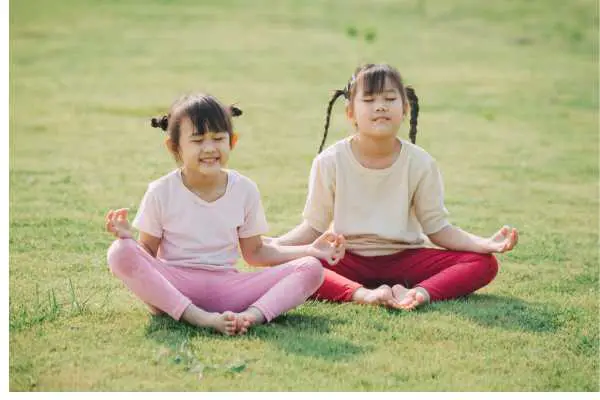
Conclusion
Meditation can be a valuable tool for promoting children’s mental health and well-being. Through regular practice, children can develop improved attention, focus, emotional regulation, and overall well-being.
It is important to adapt meditation techniques to suit individual children’s needs and preferences, and to make the practice engaging and fun. Parents, caregivers, educators, and schools all have a role to play in promoting meditation and mindfulness for children.
By prioritizing this practice and providing the necessary support and resources, we can help children develop important skills for life and promote their overall health and well-being.
Frequently Asked Questions
Can children meditate on their own or do they need adult guidance?
Younger children may need adult guidance and supervision when practicing meditation, while older children may be able to practice on their own.
However, it’s important for adults to provide guidance and support in developing a regular meditation practice.
What are some fun mindfulness activities for children?
Some fun mindfulness activities for children include mindful breathing exercises, guided meditations, mindful coloring or drawing, and mindful walking or movement exercises.
Does meditation improve learning?
There is some evidence to suggest that meditation can improve learning. One study found that regular meditation practice increased the thickness of the prefrontal cortex, a region of the brain that is important for cognitive function and executive control.
Other studies have found that meditation can improve working memory, attention, and decision-making skills, which are all important for learning. Additionally, meditation can help reduce stress and anxiety, which can interfere with learning and memory. Overall, while more research is needed, the evidence suggests that meditation may be a useful tool for improving learning and cognitive function.

